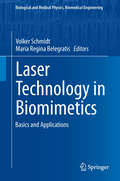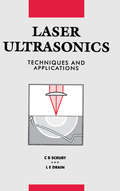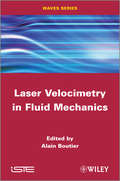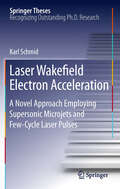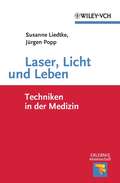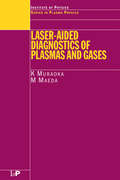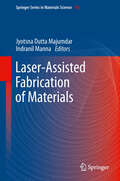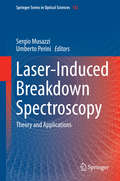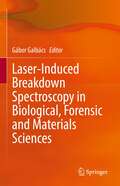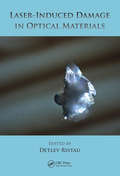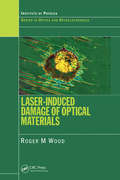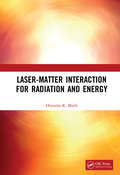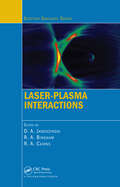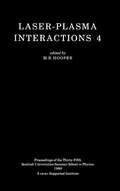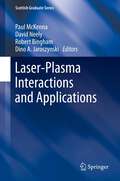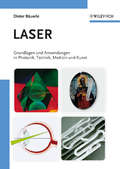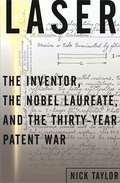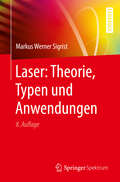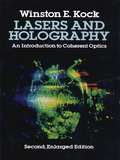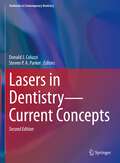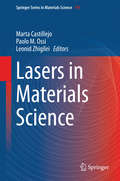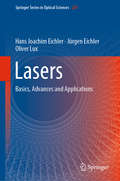- Table View
- List View
Laser Technology in Biomimetics
by Volker Schmidt Maria Regina BelegratisLasers are progressively more used as versatile tools for fabrication purposes. The wide range of available powers, wavelengths, operation modes, repetition rates etc. facilitate the processing of a large spectrum of materials at exceptional precision and quality. Hence, manifold methods were established in the past and novel methods are continuously under development. Biomimetics, the translation from nature-inspired principles to technical applications, is strongly multidisciplinary. This field offers intrinsically a wide scope of applications for laser based methods regarding structuring and modification of materials. This book is dedicated to laser fabrication methods in biomimetics. It introduces both, a laser technology as well as an application focused approach. The book covers the most important laser lithographic methods and various biomimetics application scenarios ranging from coatings and biotechnology to construction, medical applications and photonics.
Laser Ultrasonics Techniques and Applications
by L.E DrainThe first book devoted to laser techniques in the generation and reception of ultrasonic waves in materials, Laser Ultrasonics: Techniques and Applications provides a full description of the state of the art in all fields involving both lasers and ultrasonics. This practical book focuses mainly on the possible applications of the techniques, yet th
Laser Velocimetry in Fluid Mechanics
by Alain BoutierIn fluid mechanics, velocity measurement is fundamental in order to improve the behavior knowledge of the flow. Velocity maps help us to understand the mean flow structure and its fluctuations, in order to further validate codes.Laser velocimetry is an optical technique for velocity measurements; it is based on light scattering by tiny particles assumed to follow the flow, which allows the local fluid flow velocity and its fluctuations to be determined. It is a widely used non-intrusive technique to measure velocities in fluid flows, either locally or in a map.This book presents the various techniques of laser velocimetry, as well as their specific qualities: local measurements or in plane maps, mean or instantaneous values, 3D measurements. Flow seeding with particles is described with currently used products, as well as the appropriate aerosol generators. Post-processing of data allows us to extract synthetic information from measurements and to perform comparisons with results issued from CFD codes. The principles and characteristics of the different available techniques, all based on the scattering of light by tiny particles embedded in the flow, are described in detail; showing how they deliver different information, either locally or in a map, mean values and turbulence characteristics.
Laser Wakefield Electron Acceleration
by Karl SchmidThis thesis covers the few-cycle laser-driven acceleration of electrons in a laser-generated plasma. This process, known as laser wakefield acceleration (LWFA), relies on strongly driven plasma waves for the generation of accelerating gradients in the vicinity of several 100 GV/m, a value four orders of magnitude larger than that attainable by conventional accelerators. This thesis demonstrates that laser pulses with an ultrashort duration of 8 fs and a peak power of 6 TW allow the production of electron energies up to 50 MeV via LWFA. The special properties of laser accelerated electron pulses, namely the ultrashort pulse duration, the high brilliance, and the high charge density, open up new possibilities in many applications of these electron beams.
Laser, Licht und Leben: Techniken in der Medizin (Erlebnis Wissenschaft)
by Susanne Liedtke Jürgen PoppDer Mensch hat gelernt, Licht zu kontrollieren, in dem er beobachtete, wie Materie und Licht in der natürlichen Welt sich gegenseitig beeinflussen und verändern. Die neue Disziplin der Biophotonik setzt Licht als vielseitiges Werkzeug ein, um biologische Vorgänge verstehen zu lernen, Krankheiten besser diagnostizieren und heilen zu können. Mit Licht kann man berührungslos messen und Lebensvorgänge im wahrsten Sinne des Wortes 'live' beobachten. Mit Licht kann man aber auch gezielt eingreifen: Pinzetten aus Laserstrahlen halten einzelne Zellen und setzen sie zu künstlichen Geweben zusammen,. Licht kann zudem Schneiden, Bohren, Kleben oder als Katapult dienen. Das Buch gibt kurze Einführungen in die Physik und Chemie des Lichtes und die Grundlagen der Zell- und Molekularbiologie und erzählt die ebenso spannende wie erfolgreiche Geschichte der Zusammenarbeit der beiden Disziplinen im Dienste der Gesundheit des Menschen. Unter dem Motto "Light meets Life Science" eröffnen Biophotoniker im 21. Jahrhundert der Infektionsbiologie, der Krebsforschung und der Gewebezucht völlig neue Möglichkeiten.
Laser-Aided Diagnostics of Plasmas and Gases (Series in Plasma Physics)
by K Muraoka M MaedaUpdated and expanded from the original Japanese edition, Laser-Aided Diagnostics of Gases and Plasmas takes a unique approach in treating laser-aided diagnostics. The book unifies the subject by joining applications instead of describing each application as a totally separate system. In taking this approach, it highlights the relative strengths of
Laser-Assisted Fabrication of Materials
by Indranil Manna Jyotsna Dutta MajumdarLaser assisted fabrication involves shaping of materials using laser as a source of heat. It can be achieved by removal of materials (laser assisted cutting, drilling, etc.), deformation (bending, extrusion), joining (welding, soldering) and addition of materials (surface cladding or direct laser cladding). This book on ´Laser assisted Fabrication' is aimed at developing in-depth engineering concepts on various laser assisted macro and micro-fabrication techniques with the focus on application and a review of the engineering background of different micro/macro-fabrication techniques, thermal history of the treated zone and microstructural development and evolution of properties of the treated zone.
Laser-Based Measurements for Time and Frequency Domain Applications: A Handbook (Series in Optics and Optoelectronics)
by Paolo De Natale Pasquale Maddaloni Marco BelliniForeword by Nobel laureate Professor Theodor W. H�ch of Ludwig-Maximilians-UniversitätMunchenBased on the authors' experimental work over the last 25 years, Laser-Based Measurements for Time and Frequency Domain Applications: A Handbook presents basic concepts, state-of-the-art applications, and future trends in optical, atomic, and molecular physic
Laser-Induced Breakdown Spectroscopy
by Sergio Musazzi Umberto PeriniThis book deals with the Laser-Induced Breakdown Spectroscopy (LIBS) a widely used atomic emission spectroscopy technique for elemental analysis of materials. It is based on the use of a high-power, short pulse laser excitation. The book is divided into two main sections: the first one concerning theoretical aspects of the technique, the second one describing the state of the art in applications of the technique in different scientific/technological areas. Numerous examples of state of the art applications provide the readers an almost complete scenario of the LIBS technique. The LIBS theoretical aspects are reviewed. The book helps the readers who are less familiar with the technique to understand the basic principles. Numerous examples of state of the art applications give an almost complete scenario of the LIBS technique potentiality. These examples of applications may have a strong impact on future industrial utilization. The authors made important contributions to the development of this field.
Laser-Induced Breakdown Spectroscopy in Biological, Forensic and Materials Sciences
by Gábor GalbácsThis book offers a comprehensive overview of recent advances in the area of laser-induced breakdown spectroscopy (LIBS), focusing on its application to biological, forensic and materials sciences. LIBS, which was previously mainly used by physicists, chemists and in the industry, has now become a very useful tool with great potential in these other fields as well. LIBS has a unique set of characteristics including minimal destructiveness, remote sensing capabilities, potential portability, extremely high information content, trace analytical sensitivity and high throughput. With its content divided into two main parts, this book provides not only an introduction to the analytical capabilities and methodology, but also an overview of the results of recent applications in the above fields. The application-oriented, multidisciplinary approach of this work is also reflected in the diversity of the expert contributors. Given its breadth, this book will appeal to students, researchers and professionals interested in solving analytical/diagnostic/material characterization tasks with the application of LIBS.
Laser-Induced Damage in Optical Materials
by Detlev RistauDedicated to users and developers of high-powered systems, Laser-Induced Damage in Optical Materials focuses on the research field of laser-induced damage and explores the significant and steady growth of applications for high-power lasers in the academic, industrial, and military arenas. Written by renowned experts in the field, this book concentr
Laser-Induced Damage of Optical Materials (Series In Optics And Optoelectronics Ser.)
by Roger M. WoodThe laser power handling capacities of optical systems are determined by the physical properties of their component materials. At low intensity levels these factors are not important, but an understanding of damage mechanisms is fundamental to good design of laser products operating at high power. Laser Induced Damage of Optical Materials presents
Laser-Matter Interaction for Radiation and Energy
by Hitendra K. MalikThe interaction of high-power lasers with matter can generate Terahertz radiations that efficiently contribute to THz Time-Domain Spectroscopy and also would replace X-rays in medical and security applications. When a short intense laser pulse ionizes a gas, it may produce new frequencies even in VUV to XUV domain. The duration of XUV pulses can be confined down to the isolated attosecond pulse levels, required to study the electronic re-arrangement and ultrafast processes. Another important aspect of laser-matter interaction is the laser thermonuclear fusion control where accelerated particles also find an efficient use. This book provides comprehensive coverage of the most essential topics, including Electromagnetic waves and lasers THz radiation using semiconducting materials / nanostructures / gases / plasmas Surface plasmon resonance THz radiation detection Particle acceleration technologies X-ray lasers High harmonics and attosecond lasers Laser based techniques of thermonuclear fusion Controlled fusion devices including NIF and ITER The book comprises of 11 chapters and every chapter starts with a lucid introduction to the main topic. Then sub-topics are sedulously discussed keeping in mind their basics, methodology, state-of-the-art and future perspective that will prove to be salutary for readers. High quality solved examples are appended to the chapters for their deep understanding and relevant applications. In view of the nature of the topics and their level of discussion, this book is expected to have pre-eminent potential for researchers along with postgraduate and undergraduate students all over the world.
Laser-Plasma Interactions (Scottish Graduate Series)
by R. A. Cairns D. A. Jaroszynski R. BinghamA Solid Compendium of Advanced Diagnostic and Simulation ToolsExploring the most exciting and topical areas in this field, Laser-Plasma Interactions focuses on the interaction of intense laser radiation with plasma. After discussing the basic theory of the interaction of intense electromagnetic radiation fields with matter, the book covers three ap
Laser-Plasma Interactions 4 (Scottish Graduate Ser. #35)
by M. B. HooperLaser-Plasma Interactions 4 is the fourth book in a series devoted to the study of laser-plasma interactions. Subjects covered include laser light propagation, instabilities, compression and hydrodynamics, spectroscopy, diagnostics, computer code, dense plasmas, high-power lasers, X-UV sources and lasers, beat waves, and transport processes.
Laser-Plasma Interactions and Applications
by Paul Mckenna David Neely Dino Jaroszynski Robert BinghamLaser-Plasma Interactions and Applications covers the fundamental and applied aspects of high power laser-plasma physics. With an internationally renowned team of authors, the book broadens the knowledge of young researchers working in high power laser-plasma science by providing them with a thorough pedagogical grounding in the interaction of laser radiation with matter, laser-plasma accelerators, and inertial confinement fusion. The text is organised such that the theoretical foundations of the subject are discussed first, in Part I. In Part II, topics in the area of high energy density physics are covered. Parts III and IV deal with the applications to inertial confinement fusion and as a driver of particle and radiation sources, respectively. Finally, Part V describes the principle diagnostic, targetry, and computational approaches used in the field. This book is designed to give students a thorough foundation in the fundamental physics of laser-plasma interactions. It will also provide readers with knowledge of the latest research trends and elucidate future exciting challenges in laser-plasma science.
Laser: Grundlagen und Anwendungen in Photonik, Technik, Medizin und Kunst
by Dieter BäuerleDer erste Laser wurde bereits Anfang 1960 als LaborgerÞt gebaut. Erst in den vergangenen zwanzig Jahren ist es aber gelungen, Laser zuverl Þssiger, stabiler, kompakter und billiger zu erzeugen. Seither schreitet der Siegeszug von Lasern unaufhaltsam voran. Viele "technische Errungenschaften", insbesondere in der Produktionstechnik, basieren auf dem Einsatz von Lasern. Die Lasertechnik ist heute ein eigenstÞndiges Fachgebiet. Mit der Entwicklung langlebiger stabiler und billiger Halbleiterlaser in Kombination mit moderner Optik sowie einer leistungsfÞhigeren Elektronik und der.
Laser: The Inventor, the Nobel Laureate, and the Thirty-Year Patent War
by Nick TaylorIn 1957 Gordon Gould, then an obscure physicist and perennial graduate student, conceived one of the revolutionary inventions of the twentieth century -- the laser. But before he could submit a patent application, a prominent professor of physics whose office was next door to Gould's filed his own laser patent claims. Gould fought to reclaim the rights to his work, beginning a battle that would last nearly thirty years. Many millions of dollars, as well as the integrity of scientific claims, were at stake in the litigation that ensued. Laseris Gould's story -- and an eye-opening look at the patent process in America, the nexus of the worlds of business and science. Gould was struggling to finish his Ph. D. thesis when he struck upon the concept for the laser, or Light Amplification by Stimulated Emission of Radiation. Light waves, Gould realized, would form a single concentrated beam when reflected between two mirrors inside a gas-filled chamber. Even as he was sketching his invention, Gould foresaw the tremendous potential of the laser in industry, communications, and the military. For three days he feverishly documented his ideas in a notebook, which he had notarized in a candy store near his Bronx apartment. A small technology firm took a great interest in Gould's laser and soon won a Defense Department contract to develop lasers for the military. Ironically, Gould was denied a security clearance because of his past communist associations, and so was unable to work on his own invention. He could only watch from the sidelines as colleagues tried to build a working laser in a desperate race with larger, better-funded research labs. Meanwhile, Gould's rival, Charles Townes, had everything that Gould lacked, most notably important academic and government appointments and esteem in the scientific community. In the dispute between the two men, few doubted Townes's word, while nearly everyone scoffed at Gould's claims. But Gould's determination was unyielding, and he fought everyone who stood in his way, including the U. S. Patent Office, major corporations, and the entire laser industry, until he finally won. Gordon Gould, the courts ruled, had invented the laser. Laseris a grand story of technology and law. Nick Taylor has extensively interviewed Gould as well as other key participants in the battle over the laser's invention and patents. In this riveting account of genius, rivalry, and greed, he shows just how difficult it is for the legendary lone inventor to prevail when the license to a valuable invention is at stake.
Laser: Theorie, Typen und Anwendungen
by Markus Werner SigristDer fundierte Einstieg in Theorie und Anwendungen des Lasers. Das Buch enthält eine ausführliche Beschreibung und Daten aller Lasertypen mit Hinweisen auf die vielfältigen Anwendungen, die von der Materialbearbeitung, Holographie, Spektroskopie bis zur Medizin reichen. Neben den klassischen Lasern wie Rubin- oder CO2-Laser werden in dieser Neuauflage auch aktuelle Entwicklungen wie z.B. Quantenkaskadenlaser, Dioden-gepumpte Festkörperlaser und Femtosekundenlaser behandelt.
Lasers
by Jeanette LeardiLasers are a special type of light. They can cut through steal, look inside the brain of a fly, and help is explore hidden places. They are used in medical operations, at rock concerts, and in everyday items such as DVDs. How do lasers work? How have they become such a huge part of our lives in less than fifty years? Read this book to find out. (Includes 6 copies of the title, Teacher's Guide and Comprehension Question Card)
Lasers and Holography
by Winston E. KockAs the words holo (complete) and gram (message) connote, the hologram captures the entire message of a scene in all its visual properties, including the realism of three dimensions. It involves the simple process of photographically recording the pattern formed by two interfering sets of light waves, one of these sets being a reference wave. With the introduction of lasers to holography in 1963, real advances in the development of holography began to take place.Dr. Kock's lucid introduction to lasers and holography has now been revised and updated for a second edition. It begins with a clear discussion of wave patterns and coherence. Then the development of lasers is summarized, along with the phenomenon of wave diffraction. Finally, the important subjects of zone plates and the properties of holograms are skillfully described. A new, concluding chapter brings the story up to the present, with a survey of recent advances in such areas as viewing holograms, hologram computer memories, liquid surface holography, synthetic-aperture radar and sonar, large new lasers, fiber optics, etc. Using language that can be readily understood by high school and junior high school students, Dr. Kock has written a brief, yet authoritative volume that should satisfy anyone's curiosity about this burgeoning field. The remarkable discoveries that have already occurred are only a prelude to an even more remarkable future. 84 illustrations, including 8 new to this edition. New preface. Suggested (1981) additional reading. Index.
Lasers in Dentistry—Current Concepts (Textbooks in Contemporary Dentistry)
by Donald J. Coluzzi Steven P. A. ParkerThis book, now in an extensively revised second edition, provides information on the basic science and tissue interactions of dental lasers and documents the principal current clinical uses of lasers in every dental discipline. The applications of lasers in restorative dentistry, endodontics, dental implantology, pediatric dentistry, periodontal therapy, and soft tissue surgery are clearly described and illustrated. Information is also provided on laser-assisted multi-tissue management, covering procedures such as crown lengthening, gingival troughing, gingival recontouring, and depigmentation. The closing chapters look forward to the future of lasers in dentistry and the scope for their widespread use in everyday clinical practice. When used in addition to or instead of conventional instrumentation, lasers offer many unique patient benefits. Furthermore, research studies continue to reveal further potential clinical applications, and new laser wavelengths are being explored, developed, and delivered with highly specific power configurations to optimize laser–tissue interaction. This book will bring the reader up to date with the latest advances and will appeal to all with an interest in the application of lasers to the oral soft and/or hard tissues.
Lasers in Materials Science
by Marta Castillejo Paolo M. Ossi Leonid ZhigileiThis book covers various aspects of lasers in materials science, including a comprehensive overview on basic principles of laser-materials interactions and applications enabled by pulsed laser systems. The material is organized in a coherent way, providing the reader with a harmonic architecture. While systematically covering the major current and emerging areas of lasers processing applications, the Volume provides examples of targeted modification of material properties achieved through careful control of the processing conditions and laser irradiation parameters. Special emphasis is placed on specific strategies aimed at nanoscale control of material structure and properties to match the stringent requirements of modern applications. Laser fabrication of novel nanomaterials, which expands to the domains of photonics, photovoltaics, sensing, and biomedical applications, is also discussed in the Volume. This book assembles chapters based on lectures delivered at the Venice International School on Lasers in Materials Science which was held in Isola di San Servolo, Venice, Italy, in July, 2012.
Lasers in Medicine
by Ronald W. WaynantThe use of lasers in medical practice has dramatically increased over the years. Lasers and modern optics have largely been unexplored in medical science. This contributed work is both optimistic and cautionary in its expert evaluation of the state-of-the-art medical use of laser technology. The use of lasers to improve upon conventional practice i
Lasers: Basics, Advances and Applications (Springer Series in Optical Sciences #220)
by Jürgen Eichler Hans Joachim Eichler Oliver LuxThis book provides a comprehensive overview of laser sources and their applications in various fields of science, industry, and technology. After an introduction to the basics of laser physics, different laser types and materials for lasers are summarized in the context of a historical survey, outlining the evolution of the laser over the past five decades. This includes, amongst other aspects, gas lasers, excimer lasers, the wide range of solid-state and semiconductor lasers, and femtosecond and other pulsed lasers where particular attention is paid to high-power sources. Subsequent chapters address related topics such as laser modulation and nonlinear frequency conversion. In closing, the enormous importance of the laser is demonstrated by highlighting its current applications in everyday life and its potential for future developments. Typical applications in advanced material processing, medicine and biophotonics as well as plasma and X-ray generation for nanoscale lithography are discussed. The book provides broad and topical coverage of laser photonics and opto-electronics, focusing on significant findings and recent advances rather than in-depth theoretical studies. Thus, it is intended not only for university students and engineers, but also for scientists and professionals applying lasers in biomedicine, material processing and everyday consumer products. Further, it represents essential reading for engineers using or developing high-power lasers for scientific or industrial applications.
